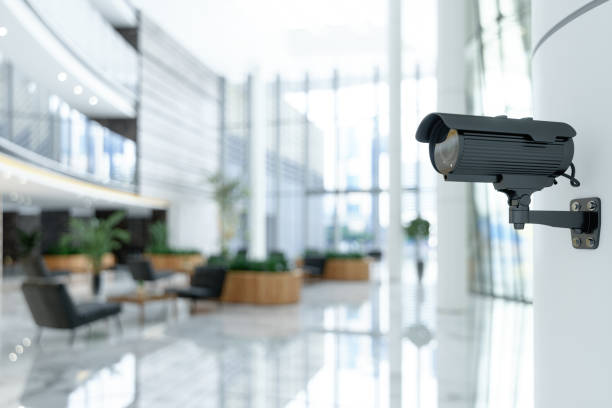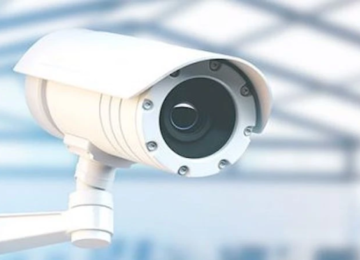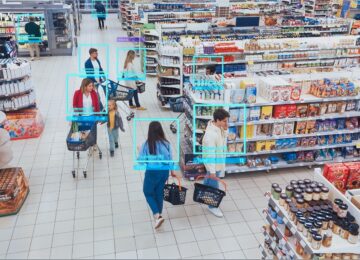How to improve the quality and usefulness of your video footage

Veesion has gathered all the important criteria to consider when choosing your video surveillance equipment in this article. We are also available to assist you in making this choice to make your smart surveillance system as efficient as possible.
"I have known franchisees who, after 3 or 4 years of capitalization, faced obsolescence of their surveillance equipment to the point that the system became ineffective, and they had to invest on their own to improve its performance."
- Nicolas, Manager of a Carrefour store and VEESION user
Let’s explore how to enhance security video quality through the selection of the right video surveillance equipment and settings.
Choosing the right equipment for clearer footage
Let’s explore how to enhance security video quality through the selection of the right video surveillance equipment monitoring and settings.
| Criteria | Recommendation |
| Resolution Video resolution corresponds to the number of pixels that make up an image, with higher resolutions offering clearer and more detailed visuals.. | 4 Mpx (2160px) |
| Frame rate The frame rate of your surveillance cameras corresponds to the number of frames captured each second. | 30 FPS |
| Compression management The video compression process is designed to reduce the size of video files, making them easier to store and transmit. | H. 265+ |
| Sound Equipment with a microphone (sound recording) and a sound system (sound emission). | No |
| Outdoor compatibility Cameras intended for outdoor use must have good build quality to withstand adverse weather conditions. | Starting from IP65 |
| Night vision Cameras equipped with infrared LED technology (IR LED). | Starlight, LightFinder ou WDR |
| Camera model | Tube for indoor use Turret for outdoor use |
| Connection mode Your surveillance system can be connected to your screens in two ways: via WiFi or wired. | Wired |
| Storage Capacity and storage modality (online or offline) | Capacity according to the surveillance device, hybrid storage mode |
| Zoom There are two types of zoom: optical zoom and digital zoom. | Digital Zoom |
| Recording mode Most surveillance systems offer 3 recording modes: continuous, motion detection, or scheduled. | Continuous or Scheduled |
| Analog or IP? | IP |
| Image sensor There are two types: CCD and CMOS | CMOS |
Resolution
Choosing the appropriate resolution is critical when considering how to enhance security video quality. If the images from your surveillance cameras are blurry, it's probably because their resolution is too low. Low-resolution cameras do not have a sufficient pixel density, resulting in a loss of detail and sharpness in the images they produce.
The right resolution for your security cameras is 4 megapixels, which is double HD (1080px). To identify a person or object, you need to maintain good image quality when zooming, which this level of resolution allows.
Sensor
The image sensor is one of the key components in the video recording quality of your security cameras. There are two types: CCD (Charged Coupled Device) and CMOS (Complementary Metal Oxide Semiconductor). The main differences between them lie in their light sensitivity and speed of converting light signals into electrical signals. While CCD, initially developed for the film industry, handles light variations better, CMOS is cheaper and faster. The difference in video quality is minimal in a retail surveillance context, making CMOS more appealing.
Field of view
The field of view corresponds to the extent of visibility offered by a camera. In a store, the horizontal field is particularly important as it helps reduce blind spots and therefore the number of cameras needed to cover your sales area. Today, there are tube cameras with angles up to 120°, turret cameras with a similar angle but with a rotating function, and panoramic cameras with angles up to 360°. The wider the angle, the larger the area covered by the camera.
Frame rate
The frame rate of your surveillance cameras corresponds to the number of frames captured each second. The frame rate of your security camera significantly impacts the clarity and fluidity of the recorded video, as well as your ability to slow down a video to better identify a suspicious gesture, for example. With a low frame rate, your video is choppy and less detailed. This rate is often expressed in FPS (Frames Per Second)
For reference, the television standard is 25 frames per second, and you need to go up to 60 frames per second for quality slow-motion views. We strongly recommend using cameras that support at least a 30 FPS frame rate. For situations where objects move relatively slowly, the frame rate can be reduced to 10-12 FPS, but this is somewhat low for a retail context. For outdoor cameras, which record faster movements and where obtaining details is crucial, cameras offering a frame rate of 60 FPS may be justified.
Compression management
The video compression process is designed to reduce the size of video files, making them easier to store and transmit. However, this file size reduction comes at a cost: video data loss.
During compression, some details are removed or simplified to achieve smaller file sizes, which can degrade video quality, resulting in pixelation and reduced overall image quality.
The more an image is compressed, the more these issues become visible. Therefore, finding a balance between file size and video quality is essential when choosing a security camera system.
The main recommended compression formats on the market for video surveillance are H.264 and H.265+. While H.264 is sufficient for resolutions up to 8k, H.265+ offers superior image quality for a smaller size.
Sound
Some surveillance cameras have a microphone and a sound system, allowing both recording and sound emission. Our recommendation is not to seek this option for your future equipment, as it doesn't add much value for a retail setting and increases your file sizes (thus increasing your storage capacity needs).
Night vision
For surveillance cameras that operate day and night, prioritize cameras equipped with low-light infrared technology. Thanks to their infrared LEDs (IR LEDs), these security cameras can record quality images even in complete darkness. Technologies like Starlight, LightFinder, or WDR (Wide Dynamic Range) are reputable options on the market.
Camera models
Bullet cameras, dome cameras, PTZ (Pan, Tilt, Zoom) cameras, panoramic cameras, tube cameras, turret cameras, thermal cameras, panoramic cameras… The various types and names of surveillance cameras can be overwhelming. Here are some guidelines to help you choose the best one for your needs.
Motorized cameras, such as PTZ turrets and domes, are ideal for covering large areas. They can sweep the area to be monitored and can be controlled remotely, making them better suited for outdoor use. However, for AI-based store surveillance, tube cameras are preferable. Tubes effectively monitor aisles at a controlled budget. While domes offer a panoramic view of larger areas, they create a fisheye effect on images, which is a major drawback for intelligent surveillance systems.
"Our recommendation is to prioritize fixed cameras over domes or rail cameras. While domes distort images, rail cameras do not offer enough stability for optimal AI usage. Our system not only monitors movements but also analyzes the environment of each camera for maximum efficiency. Therefore, monitoring a fixed area provides better performance"
- Romain GALLET, Sales Director France / BENELUX
Connection mode
Your security cameras can be connected to your screens in two ways: via WiFi or wired. For a retail environment, a wired surveillance system is recommended as data transmission is faster. This results in better image quality and responsiveness.
Storage
The law limits the retention of your security camera recordings to 30 days. However, the required storage capacity for these 30 days of video can vary greatly depending on the camera resolution, frame rate, video compression, and recording mode chosen. For example, a store equipped with 10 high-quality cameras (4 MP, 30 FPS, H.265+ format), recording from 8 AM to 10 PM, six days a week, will need 6 TB of storage.
These recordings can be stored locally (hard drive) or online (cloud). While a hard drive is more economical, it does not allow remote video consultation. Conversely, the cloud offers this capability, and storage volume can be adjusted as needed. However, the cloud is billed monthly for the duration of your surveillance system usage and depends on an internet connection. In both cases, it is imperative to protect this data, as it is your responsibility.
To avoid losing the use of your surveillance system, the best option is to pair a cloud subscription with a local backup solution.
Zoom
There are two types of zoom: optical zoom and digital zoom. Optical zoom is the most powerful, but we recommend digital zoom for retail security cameras. Only digital zoom can be used during delayed viewing of images.
Recording mode
Most modern surveillance systems offer three recording modes to adapt to various contexts: continuous, motion detection, or scheduled. The first records non-stop, the second only when motion is detected, and the last only during defined time slots. Continuous recording is always available; however, you need to ensure that the equipment you purchase can be programmed if you want your cameras to operate only during your store's opening hours.
Analog or IP?
If you have a tight budget, you might lean towards analog cameras. However, it's important to know that while they are cheaper upfront, they require more maintenance and offer less security. Although Veesion works well with both analog surveillance systems and IP camera systems, we recommend IP for better performance.
"One advantage of modern surveillance systems is that they greatly facilitate the installation of complementary solutions like Veesion"
Romain GALLET, Sales Director France / BENELUX
For more information, check our full article: How to choose between an analogue camera and an IP camera for your CCTV system?
How to maintain surveillance hardware over time
For effective surveillance equipment monitoring, it's essential to choose high-quality cameras and reliable storage methods. To ensure optimal video quality and prolong the life of your equipment, it is essential to regularly maintain and repair your security cameras. Over time, dust, dirt, and debris can accumulate on the camera lens, affecting the clarity of the recorded images. Regular cleaning of the camera is necessary to remove any obstructions that could impair video quality.
Additionally, regularly check that connections are secure and cables are not damaged to avoid signal loss or interference. Routine inspection and maintenance will help identify potential issues before they become major problems.
Here are some tips to maintain the sharpness of your security camera videos:
- Install a lens cover to facilitate lens maintenance and protect your camera lenses from deterioration
- Regularly clean the lenses or lens coversi
- Spray repellent on the lenses between April and October, the nesting period for most insects, as the lenses can attract them
For more maintenance tips, check out: Camera maintenance: the right steps to optimise your CCTV system
Cameras intended for outdoor use must have good build quality to withstand adverse weather conditions. If you are equipping for this purpose, consider the IP (Ingress Protection) rating. The IP code consists of two digits: the first indicates protection against dust, while the second indicates water resistance. The higher the rating, the more resistant your equipment will be to various environmental factors. For highly water-resistant cameras, consider an IP66 rating. This type of camera offers total dust protection and strong water resistance (maritime conditions).
Details of the IP code:
| Index | 1st Digit (Tens place) Protection against solids | 2nd Digit (Units place) Protection against water intrusion |
| 0 | No protection | No protection |
| 1 | Protected against solid objects over 50 mm | Protected against vertically falling water drops |
| 2 | Protected against solid objects over 12.5 mm | Protected against vertically falling water drops when tilted up to 15° |
| 3 | Protected against solid objects over 2.5 mm | Protected against water spray up to 60° from the vertical |
| 4 | Protected against solid objects over 1 mm | Protected against water splashes from all directions |
| 5 | Protected against dust and other microscopic residues | Protected against water jets from all directions (6.3 mm nozzle, 2.5 to 3 m distance, 12.5 l/min ±5%) |
| 6 | Totally protected against dust | Protected against powerful water jets from all directions (12.5 mm nozzle, 2.5 to 3 m distance, 100 l/min ±5%) |
| 7 | Protected against temporary immersion in water up to 1 m for 30 min | |
| 8 | Submersible beyond 1 m under specified conditions by the manufacturer for duration and pressure |
Source : Wikipedia
The most popular
Related news
Discover what Veesion can do for you. Do you have one or more stores?
Our team will contact you within 48 hours





